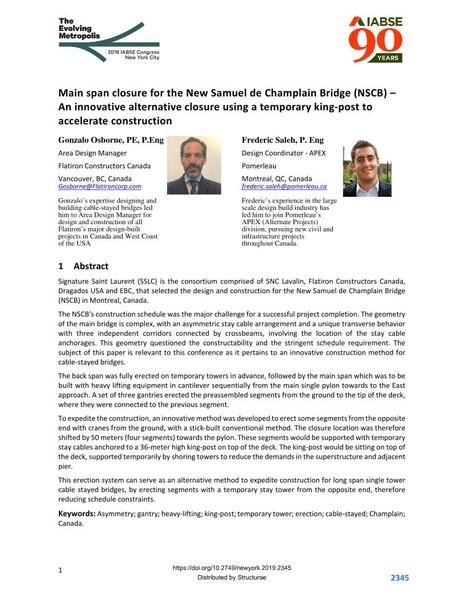Main span closure for the New Samuel de Champlain Bridge (NSCB) - An innovative alternative closure using a temporary king-post to accelerate construction

|
|
|||||||||||
Bibliografische Angaben
| Autor(en): |
Gonzalo Osborne
(Flatiron Constructors Canada)
Frederic Saleh (Pomerleau) |
||||
|---|---|---|---|---|---|
| Medium: | Tagungsbeitrag | ||||
| Sprache(n): | Englisch | ||||
| Tagung: | IABSE Congress: The Evolving Metropolis, New York, NY, USA, 4-6 September 2019 | ||||
| Veröffentlicht in: | The Evolving Metropolis | ||||
|
|||||
| Seite(n): | 2345-2352 | ||||
| Anzahl der Seiten (im PDF): | 8 | ||||
| DOI: | 10.2749/newyork.2019.2345 | ||||
| Abstrakt: |
Signature Saint Laurent (SSLC) is the consortium comprised of SNC Lavalin, Flatiron Constructors Canada, Dragados USA and EBC, that selected the design and construction for the New Samuel de Champlain Bridge (NSCB) in Montreal, Canada. The NSCB’s construction schedule was the major challenge for a successful project completion. The geometry of the main bridge is complex, with an asymmetric stay cable arrangement and a unique transverse behavior with three independent corridors connected by crossbeams, involving the location of the stay cable anchorages. This geometry questioned the constructability and the stringent schedule requirement. The subject of this paper is relevant to this conference as it pertains to an innovative construction method for cable-stayed bridges. The back span was fully erected on temporary towers in advance, followed by the main span which was to be built with heavy lifting equipment in cantilever sequentially from the main single pylon towards to the East approach. A set of three gantries erected the preassembled segments from the ground to the tip of the deck, where they were connected to the previous segment. To expedite the construction, an innovative method was developed to erect some segments from the opposite end with cranes from the ground, with a stick-built conventional method. The closure location was therefore shifted by 50 meters (four segments) towards the pylon. These segments would be supported with temporary stay cables anchored to a 36-meter high king-post on top of the deck. The king-post would be sitting on top of the deck, supported temporarily by shoring towers to reduce the demands in the superstructure and adjacent pier. This erection system can serve as an alternative method to expedite construction for long span single tower cable stayed bridges, by erecting segments with a temporary stay tower from the opposite end, therefore reducing schedule constraints. |
||||
| Stichwörter: |
Errichtung
|
||||
